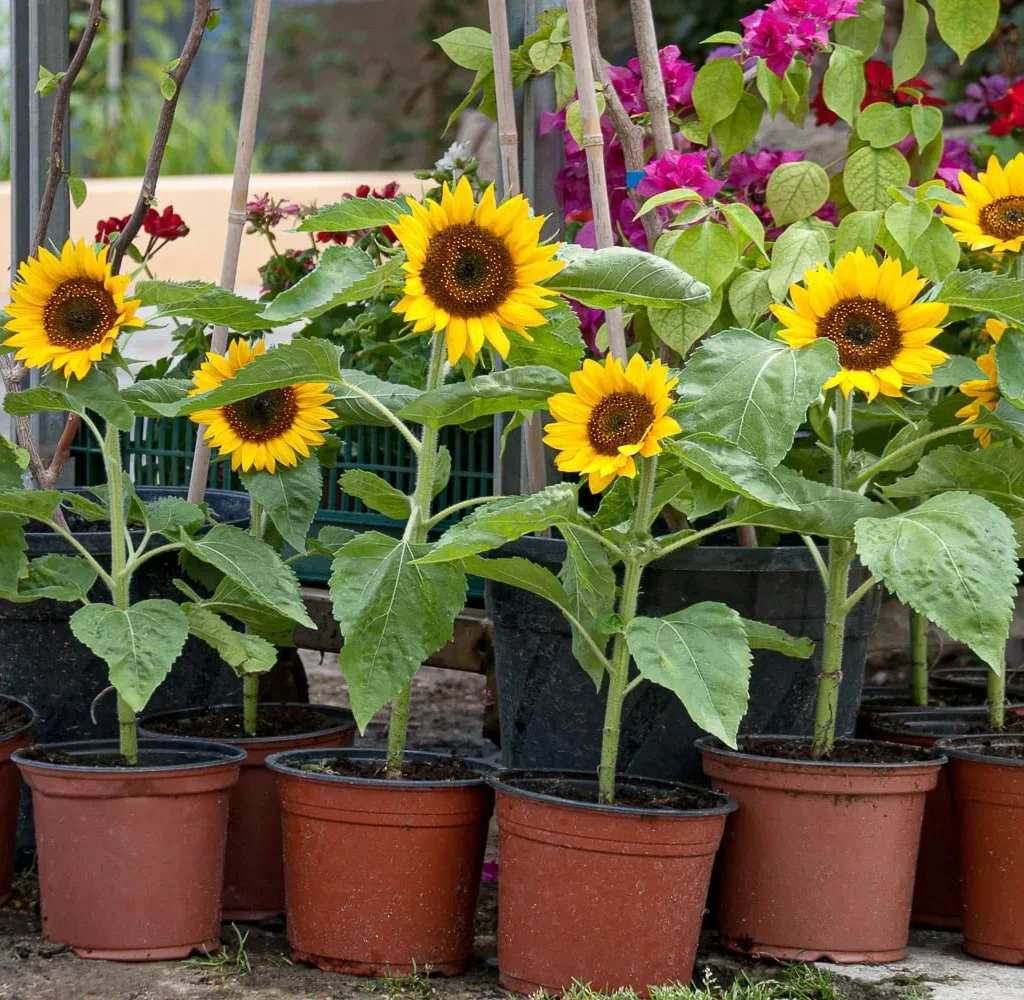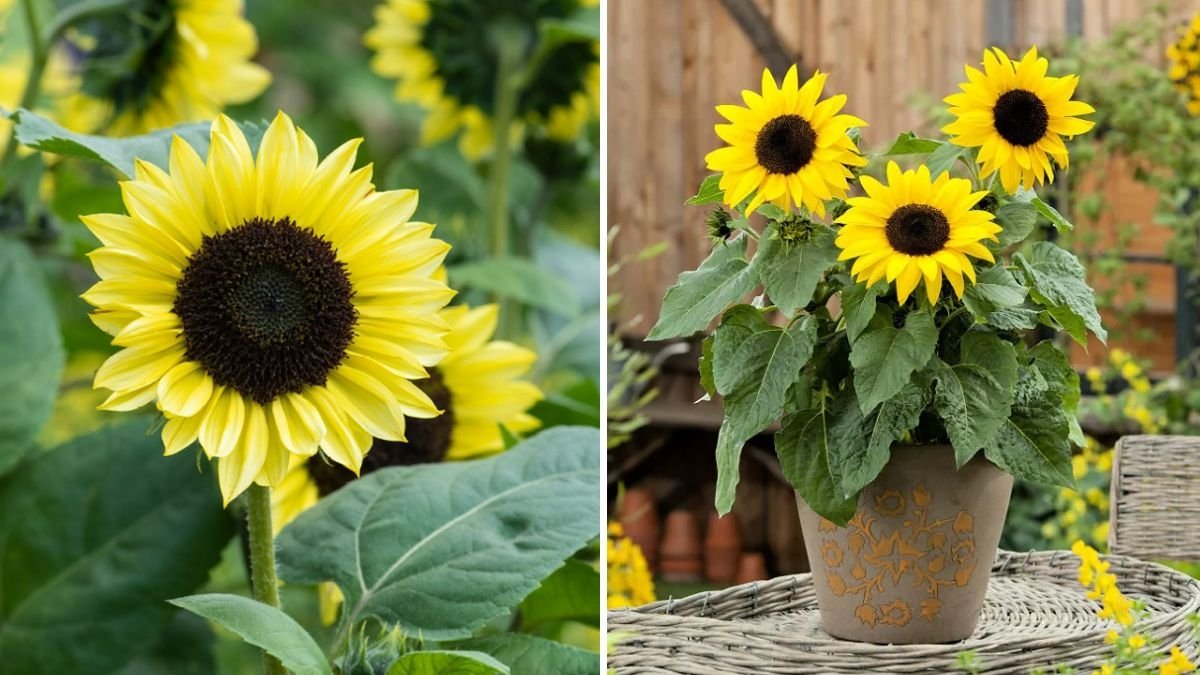Sunflowers (Helianthus annuus) are iconic garden plants known for their bright yellow blooms, towering stems, and cheerful appearance. While traditionally grown in garden beds, sunflowers can also thrive in containers, making them ideal for patios, balconies, and small gardens. Growing sunflowers in containers allows gardeners to enjoy their beauty even with limited space, control soil conditions, and easily move plants to optimize sunlight exposure. This article provides a comprehensive guide on how to grow sunflowers in containers, including container selection, soil preparation, watering, fertilization, pest control, and harvesting tips.
1. Benefits of Growing Sunflowers in Containers

Container gardening offers several advantages for sunflower cultivation:
- Space Efficiency: Ideal for small gardens, balconies, patios, and urban spaces.
- Soil Control: Allows customization of soil type, pH, and fertility for optimal growth.
- Mobility: Containers can be moved to follow sunlight or protect plants from strong winds.
- Pest Management: Easier to monitor and control pests compared to in-ground planting.
- Decorative Appeal: Adds height, color, and visual interest to patios and decks.
By choosing containers, gardeners can cultivate sunflowers successfully even without traditional garden beds.
2. Choosing the Right Container

The container is crucial for sunflower growth because these plants have deep, robust root systems:
- Size: Choose containers at least 12–18 inches deep for dwarf varieties and 18–24 inches deep for larger varieties.
- Width: A wider container (12–18 inches in diameter) provides stability for tall sunflowers.
- Drainage: Ensure containers have adequate drainage holes to prevent waterlogging and root rot.
- Material: Terracotta, plastic, ceramic, or wooden containers all work; terracotta is porous and aids soil aeration, while plastic retains moisture longer.
Choosing the right container ensures healthy root development and stable plant growth.
3. Selecting Sunflower Varieties for Containers
Not all sunflower varieties are suitable for containers. Consider dwarf or compact types for limited space:

- Dwarf Varieties: ‘Teddy Bear,’ ‘Big Smile,’ ‘Sunspot’ – reach 12–24 inches in height, perfect for small containers.
- Medium Varieties: ‘Autumn Beauty,’ ‘Lemon Queen’ – reach 3–4 feet, suitable for large containers.
- Tall Varieties: ‘Mammoth,’ ‘Russian Giant’ – reach 6–12 feet, require very deep and heavy containers for stability.
Selecting the right variety ensures proportionate growth and prevents container tipping.
4. Soil Preparation
Sunflowers thrive in nutrient-rich, well-draining soil:
- Soil Type: Use a high-quality potting mix enriched with compost or organic matter. Avoid heavy garden soil that can compact in containers.
- pH Level: Sunflowers prefer slightly acidic to neutral soil (pH 6.0–7.5).
- Soil Additives: Incorporate perlite or coarse sand to improve drainage and aeration.
- Fertility: Mix in a balanced slow-release fertilizer to support vigorous growth and flower development.
Proper soil preparation ensures strong roots, vibrant leaves, and abundant blooms.
5. Planting Sunflowers in Containers

Planting sunflowers correctly in containers is essential for healthy growth:
a. Sowing Seeds
- Plant seeds 1–2 inches deep directly in the container.
- Space seeds 4–6 inches apart for dwarf varieties and 6–12 inches for larger varieties.
- Cover seeds with soil and water gently to settle them.
b. Germination
- Sunflower seeds germinate in 7–10 days under optimal conditions.
- Maintain soil moisture during germination but avoid waterlogging.
c. Thinning Seedlings
- Once seedlings develop 2–3 true leaves, thin them to the strongest plant per space allowance to prevent overcrowding.
Proper planting techniques ensure robust growth and healthy flower development.
6. Light Requirements
Sunflowers are sun-loving plants and require ample light for growth:
- Sunlight: Provide at least 6–8 hours of direct sunlight daily.
- Container Mobility: Move containers to follow the sun if needed, especially on shaded patios.
- Indoor Growth: If growing indoors, supplement with grow lights to ensure adequate light exposure.
Adequate light promotes tall stems, strong leaves, and large vibrant blooms.
7. Watering Sunflowers in Containers
Sunflowers need consistent moisture, but overwatering can harm them:
- Frequency: Water when the top 1–2 inches of soil feel dry.
- Method: Water slowly until soil is thoroughly moistened; ensure drainage holes are functional.
- Mulching: Add a thin layer of organic mulch to retain soil moisture and regulate temperature.
- Avoid Overwatering: Standing water can lead to root rot and fungal diseases.
Balanced watering supports steady growth and flowering.
8. Fertilization

Sunflowers are heavy feeders, especially in containers where nutrients are limited:
- Initial Fertilization: Mix slow-release fertilizer into soil at planting.
- Regular Feeding: Apply a balanced liquid fertilizer every 2–3 weeks during the growing season.
- Flower Support: High-phosphorus fertilizers promote robust flower development.
- Avoid Excess Nitrogen: Too much nitrogen encourages foliage growth at the expense of flowers.
Proper fertilization encourages healthy foliage, sturdy stems, and abundant blooms.
9. Supporting Tall Varieties
Tall sunflowers in containers need structural support:
- Stakes or Trellises: Use bamboo stakes or garden cages to prevent stems from bending or breaking.
- Tying Plants: Secure stems gently with soft ties to stakes for stability.
- Wind Protection: Place containers in sheltered areas during strong winds.
Support ensures sunflowers remain upright and healthy, enhancing their ornamental appeal.
10. Pest and Disease Management
Sunflowers in containers are generally resilient, but monitoring is necessary:
- Common Pests: Aphids, caterpillars, and spider mites.
- Prevention: Regularly inspect leaves and stems; use insecticidal soap or neem oil if infestations occur.
- Diseases: Powdery mildew, rust, or root rot can occur in poorly drained containers.
- Solution: Ensure proper watering, adequate sunlight, and good airflow around plants.
Early detection and preventive measures keep sunflowers healthy and vibrant.
11. Deadheading and Encouraging Continued Blooms
Deadheading spent flowers encourages longer bloom periods:
- Method: Pinch off faded blooms just above the next set of leaves.
- Benefits: Prevents the plant from diverting energy to seed production, prolonging flowering.
- Seed Harvesting: If you want sunflower seeds, allow some blooms to mature naturally.
Proper deadheading balances flower longevity with potential seed production.
12. Winter Care and Container Placement
Sunflowers are annuals, but container-grown plants can benefit from care during cooler months:
- Indoors in Cold Climates: Move containers indoors if temperatures drop below freezing.
- Mulching: Add extra mulch for root insulation if left outdoors.
- Cleaning: Remove dead leaves to prevent fungal growth and pests.
Winter care ensures prolonged health and the possibility of seed harvesting.
13. Harvesting Sunflower Seeds
For gardeners interested in edible or decorative seeds:
- Allow blooms to mature fully on the plant, with petals falling off naturally.
- Harvest when the back of the flower turns yellow-brown.
- Dry seeds in a cool, dry location before storage.
- Use seeds for snacking, bird feed, or replanting.
Harvesting adds practical value to container-grown sunflowers.
14. Tips for Optimal Container Sunflower Growth
- Choose compact varieties if limited on space.
- Use deep containers for strong root systems.
- Provide consistent water without overwatering.
- Fertilize regularly but avoid excessive nitrogen.
- Support tall plants with stakes or trellises.
- Ensure at least 6–8 hours of sunlight daily.
- Rotate containers periodically to prevent leaning toward sunlight.
- Monitor pests and diseases regularly for early intervention.
Following these tips ensures container sunflowers thrive and produce stunning blooms.
15. Decorative Uses of Container Sunflowers
Container sunflowers are versatile for home decor:
- Patio and Balcony Displays: Brighten outdoor living spaces with bold colors.
- Indoor Arrangements: Large blooms make excellent cut flowers for vases.
- Vertical Gardens: Tall varieties create focal points or natural screens.
- Mixed Plantings: Combine with trailing plants or ornamental grasses for a dynamic container display.
The versatility of container sunflowers enhances both aesthetic and functional garden design.
16. Conclusion
Growing sunflowers in containers is a rewarding and manageable way to enjoy these cheerful flowers in any space. By selecting suitable varieties, preparing nutrient-rich soil, ensuring adequate sunlight, and providing proper watering, fertilization, and support, gardeners can achieve healthy, vibrant blooms year after year. Container gardening allows flexibility, mobility, and control, making sunflowers accessible to both novice and experienced gardeners.
Key Takeaways:
- Choose dwarf or compact varieties for containers; larger varieties require deep, heavy pots.
- Use well-draining, nutrient-rich soil to support root development.
- Provide consistent sunlight and water for optimal growth.
- Support tall plants to prevent bending or breaking.
- Deadhead and harvest seeds to prolong blooms and enjoy practical benefits.
- Monitor pests and diseases to ensure healthy, long-lasting plants.
With these strategies, sunflowers can thrive in containers, providing beauty, joy, and even edible seeds for any gardener, regardless of space constraints. Container-grown sunflowers are a perfect combination of convenience, aesthetics, and gardening satisfaction.

Leave A Comment